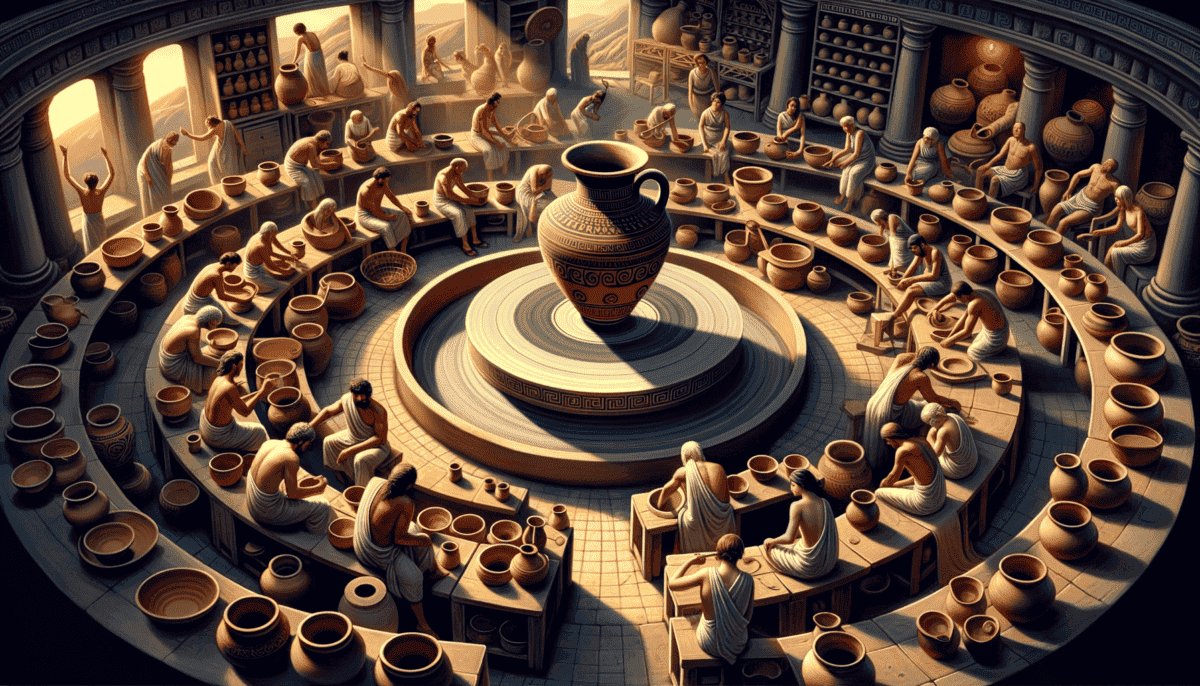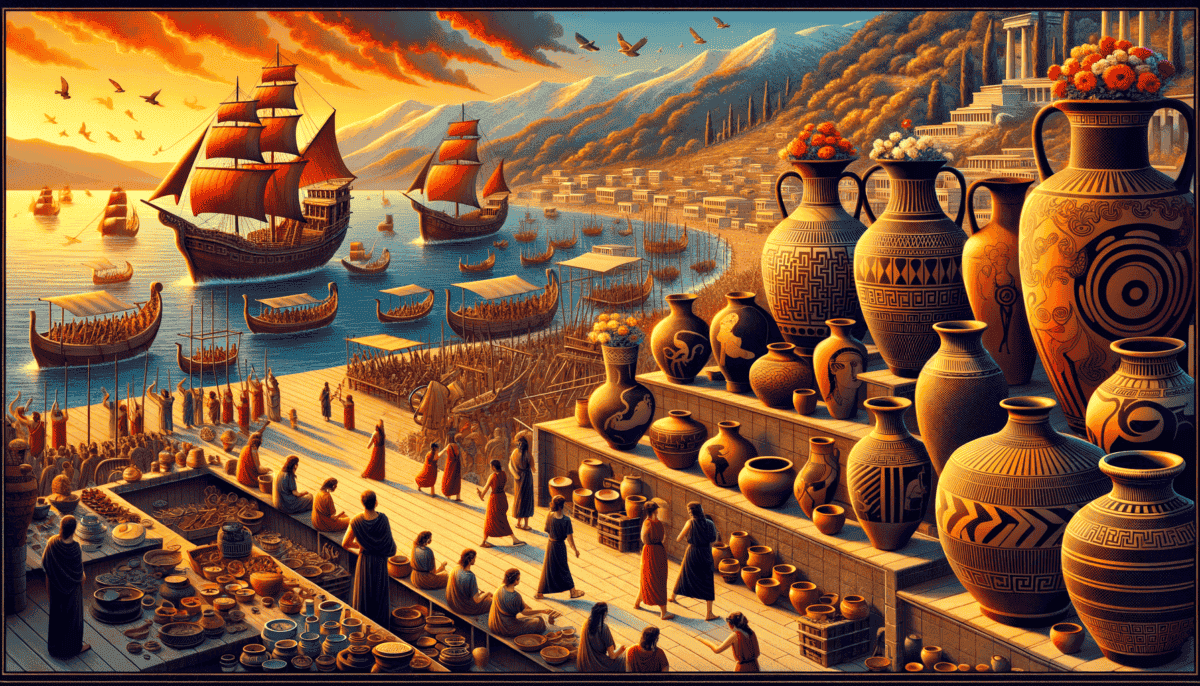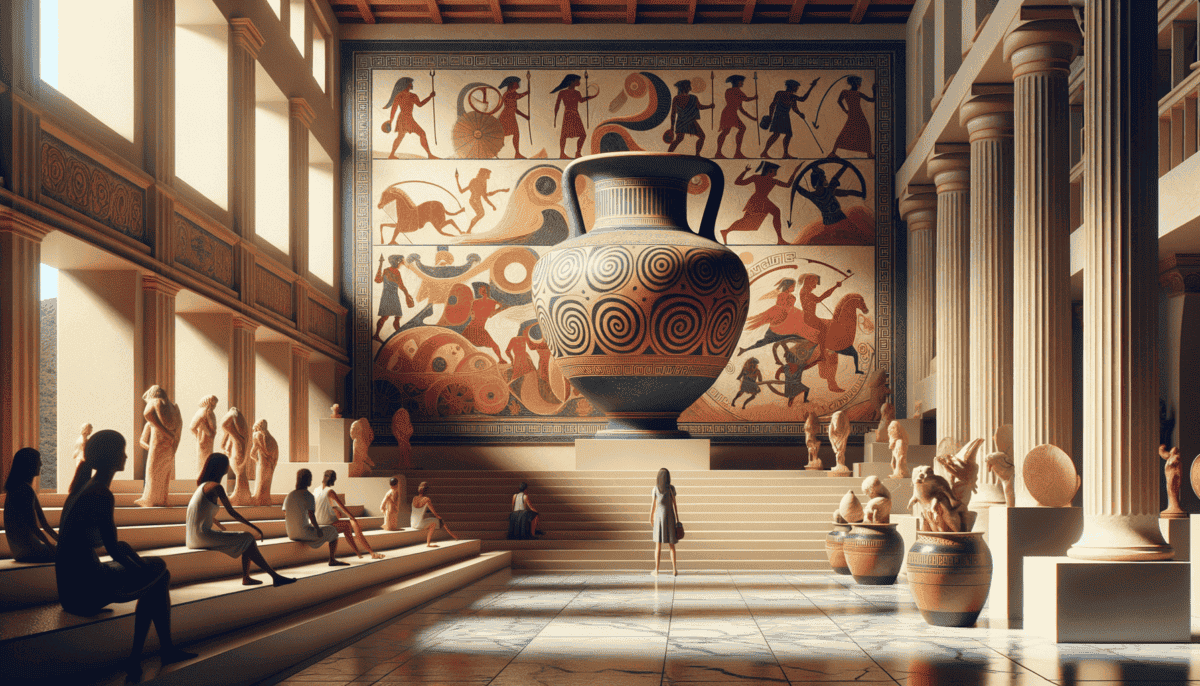The Clay Begins
In a small village by the Aegean Sea, a special piece of clay began its journey. The clay was soft and brown, waiting to become something amazing. Little did it know, it would one day be known as Euphronios, a very special pot!
The sun was warm on the potter's workbench as Maria, a young potter, picked up the clay. Her hands were gentle but strong. "What shall I make today?" she wondered out loud, smiling at the lump of clay.
Her grandfather, Master Potter Demetrius, walked over. His beard was white as snow, and his eyes twinkled with wisdom. "Remember, little one," he said, "every pot starts with a simple pinch."
Maria nodded and pushed her thumb into the middle of the clay ball. She worked slowly, pinching and smoothing. The clay began to take shape under her careful fingers.
“Look, Grandfather!” Maria exclaimed. “It’s growing taller!”
Indeed, the clay was becoming a small pot. Maria used her fingers to make the walls smooth. She had learned from watching her grandfather that good pots needed smooth walls to hold water.
“In our village, every pot tells a story,” Grandfather Demetrius said. “Some hold water for drinking. Others keep our olive oil safe. And some,” he winked, “become very special treasures.”
As the day went on, more pots appeared on the workbench. Some were big enough to hold food for a whole family. Others were small, perfect for holding honey or special oils. Each one was made by hand, just like people had been making them for thousands of years.
• Storing food and water
• Cooking meals
• Keeping olive oil fresh
• Carrying things from place to place
The sun began to set, painting the sky orange and pink. Maria looked at her finished pot with pride. It wasn't perfect – it had a few wobbles here and there – but it was strong and ready for its next step.
“Tomorrow,” Grandfather Demetrius said, “we will put your pot in the fire. The flames will make it strong, and its real journey will begin.”
That night, as stars twinkled above the village, the little pot that would become Euphronios sat quietly on the shelf. It had started as simple clay, but already it was becoming something more. In the quiet darkness, it dreamed of all the adventures that lay ahead.
The moon cast soft shadows through the workshop window. Tomorrow would bring new challenges and changes. The fire would make the clay hard and strong. But for now, the little pot rested, ready for whatever adventures tomorrow might bring.
Geometric Whispers
The morning sun sparkled through the workshop windows. Our little pot, Euphronios, was no longer soft brown clay. The fire had made it strong and a lovely orange-red color!
“Look how beautiful it turned out!” Maria exclaimed, carefully picking up her creation.
But something new was happening in the workshop. Grandfather Demetrius had brought out special tools – tiny brushes and dark paint made from clay and water.
Maria watched as her grandfather dipped a thin brush in the dark paint. His hand moved steadily, drawing perfect straight lines around a pot.
“Each line we draw has meaning,” Grandfather explained. “These triangles represent mountains. These waves show the sea. When we put them together, they tell stories about our world.”
Maria’s eyes grew wide with wonder. She had never thought about pots being used to tell stories before! Looking at Euphronios, she imagined all the patterns she could add.
“Can I try, Grandfather?” she asked eagerly, reaching for a brush.
Demetrius smiled and nodded. He showed her how to hold the brush just right. Maria started with simple lines, carefully going around Euphronios. Her first attempts were wobbly, but she kept trying.
• Straight lines
• Circles
• Triangles
• Zig-zag patterns
• Diamond shapes
As days passed, Maria got better at painting. She learned that different patterns meant different things. Circles could be the sun or the full moon. Zig-zag lines could show running water or mountains far away.
“Your patterns are getting stronger,” Grandfather praised. “Soon you’ll be ready to paint stories about our heroes and gods!”
Other potters in the village started visiting their workshop. They brought their own pots decorated with new patterns. Some had pictures of boats sailing on wavy lines. Others showed animals running between geometric shapes.
Euphronios was proud of its new decorations. The patterns Maria had painted told the story of their village – the sea, the mountains, and the sun that watched over them all. But this was just the beginning of its journey into becoming a storyteller.
As the workshop grew quiet for the evening, the moonlight made the painted patterns dance on Euphronios’s surface. Tomorrow would bring new patterns, new stories, and perhaps even bigger changes. The age of geometric patterns was just the start of an amazing artistic adventure.
The Potter’s Wheel Revolution
One bright morning, Euphronios noticed something new in the workshop. A strange wooden disk sat on a tall stand.
“What is that, Grandfather?” Maria asked, pointing at the strange new tool.
Demetrius’s eyes sparkled with excitement. “This, my dear, is a potter’s wheel. It will change everything about how we make pots!”
Maria watched as Grandfather put a lump of clay on the wheel. He pushed a pedal with his foot, and the wheel began to spin! His hands shaped the clay like magic.
“See how the clay dances?” Grandfather said. “With this wheel, we can make pots faster and prettier than ever before!”
Maria couldn’t wait to try. Her first attempt made a big mess! Clay flew everywhere, making them both laugh.
“Don’t worry,” Grandfather smiled, wiping clay from his nose. “It took me many tries to learn too.”
• Taller pots
• Rounder shapes
• Smoother sides
• Matching sets
• Fancier designs
Day after day, Maria practiced on the wheel. Her hands learned to guide the clay. Soon she could make pots as tall as herself!
“The wheel lets us dream bigger,” Grandfather explained. “We can make pots for kings and temples now!”
Other potters came to see the magical wheel. Some brought their own wheels and shared new tricks. The workshop buzzed with excitement as everyone learned together.
Looking at Euphronios, Maria remembered how hard it was to make pots by hand. Now she could make ten pots in the time it took to make one before!
The wheel spun faster and faster. Clay transformed into beautiful shapes. Tall vases, wide bowls, and delicate cups filled the workshop shelves.
“Every spin of the wheel brings new ideas,” Demetrius said proudly. “Just wait until you see what we’ll create next!”
That night, Euphronios watched the newer pots showing off their perfect shapes. The potter’s wheel had started something amazing. But even bigger changes were coming – changes that would turn simple clay pots into magical storytellers.
As the stars twinkled outside, the workshop hummed with possibilities. The spinning wheel had opened a door to new adventures in pottery making. Tomorrow would bring more surprises, more learning, and more beautiful creations.
Mythological Canvases
The workshop glowed with warm light as Maria stared at Euphronios. Something amazing was happening – the pot’s surface was becoming a magical canvas!
“Look, Grandfather!” Maria exclaimed. “Our pots are telling stories now!”
Demetrius smiled as he carefully painted a scene on Euphronios. “Yes, little one. Today we learn about black-figure painting. Watch how the figures dance on the clay.”
Maria watched closely as Grandfather painted brave heroes and mighty gods. There was Hercules fighting the lion, and Zeus throwing lightning bolts! ⚡
“Each pot becomes a storybook,” Grandfather explained. “People will learn about our gods and heroes just by looking at them.”
Then something even more exciting happened. A traveling artist visited their workshop with a new way of painting called red-figure technique.
“Instead of black figures, we leave the clay red and paint the background black,” the artist showed them. “See how much more detail we can add?”
• Hercules and his mighty tasks
• The Trojan War battles
• Olympic games and athletes
• Gods and goddesses
• Heroes and monsters
Maria loved learning about all the stories. Each pot became a window into amazing adventures.
“Which story is your favorite?” she asked Euphronios one evening.
If Euphronios could talk, he would say he loved them all! His surface now showed beautiful scenes of Apollo playing music while the Muses danced.
Other potters came from far away to learn these new painting styles. Soon the workshop was full of colorful scenes from all the best stories.
“Our pots will help people remember these tales forever,” Grandfather said proudly. “Each one carries a piece of our history.”
As night fell, Maria looked at all the painted pots glowing in the lamplight. Heroes fought monsters, gods rode chariots across the sky, and athletes competed in great games.
Each pot was special, but Euphronios was her favorite. His paintings were so beautiful that people would stop and stare. Nobody could walk past without wanting to hear the stories he showed.
The workshop had become more than just a place to make pots. It was now a place where stories came alive in clay and color. More adventures waited ahead, as Euphronios prepared for an exciting journey across the sea.
Across the Great Sea
The salty breeze ruffled Maria’s hair as she watched the sailors load Euphronios onto the big trading ship.
“Be brave, Euphronios!” Maria whispered. “You’re going on a great adventure!”
Grandfather put his hand on her shoulder. “Our pots travel far and wide now. People everywhere want to see our beautiful stories.”
The captain checked his map and smiled at Maria. “First stop is Egypt, then we sail to Italy. Your pot will see many wonderful places!”
“The sea can be rough,” the captain warned, “but we pack the pots carefully in soft straw to keep them safe.”
As the ship sailed away, Maria imagined Euphronios’s journey. Would he see the pyramids? Would Roman children admire his paintings?
• Egypt’s mighty pyramids
• Rome’s busy markets
• Spanish coastal towns
• Turkish trading ports
• Far-away Persian cities
The ship bounced over waves, carrying its precious cargo to new homes. Other traders brought different treasures back to Greece – spices, cloth, and new ideas.
In every port, people gathered to see the beautiful Greek pots. They loved the stories painted on them and wanted to learn about Greek heroes and gods.
Months later, exciting news reached the workshop. Euphronios had arrived safely in Rome! A wealthy family bought him to display in their garden. ️
“Your pot is teaching Romans about our culture,” Grandfather told Maria proudly. “That’s how ideas spread – one beautiful pot at a time.”
Other pots from the workshop began amazing journeys too. Some went north to trade with Celtic tribes. Others sailed east to Persian palaces.
Each time a ship returned, it brought stories of how people far away loved Greek art. Children in other lands learned Greek myths from the painted scenes, just like Maria had.
“Will I ever see Euphronios again?” Maria asked one evening.
Grandfather smiled. “Perhaps someday. But remember – he’s doing important work, helping people everywhere understand our stories and art.”
The workshop stayed busy making more pots for trade. Each one carried a piece of Greek culture to distant shores, building bridges between different peoples through art and stories.
As Maria worked on new pots, she imagined them sailing to faraway places like Euphronios. Maybe somewhere, another child was looking at his beautiful paintings right now, learning about Greek heroes and gods for the first time.
A Home in History
The bright lights of the museum shone down on Euphronios. After thousands of years, he had found a special new home. ️
“Look at this amazing Greek pot!” a young girl named Sophie exclaimed. “The paintings are still so bright!”
Sophie pressed her nose against the glass case. Her class was visiting the museum to learn about ancient Greece.
The museum guide smiled at the children. “This pot has had quite a journey. It started in Greece, traveled to Rome, and now helps us learn about history.”
“See how carefully they painted these stories?” the guide pointed out. “Each picture shows us what ancient Greeks thought was important.”
Sophie thought about Maria, the potter’s granddaughter from long ago. Would she be happy to know her pot was still teaching people?
• How people lived
• Stories they loved
• Art they made
• Things they believed
• Places they went
Scientists use special tools to study the pots. They learn about the clay, the paints, and how the pots were made.
Other children gathered around Euphronios. They pointed at the heroes and monsters in his paintings. Just like children did thousands of years ago!
In his glass case, Euphronios felt proud. From his simple start as clay by a river, he had become a teacher of history.
“These pots are like time machines,” Sophie said. “They let us see into the past!”
The museum workers carefully cleaned and protected Euphronios. They wanted him to keep sharing his stories for many more years.
Sometimes at night, when the museum was quiet, Euphronios remembered his long journey. From Maria’s workshop to the trading ship, from Roman gardens to modern museums.
“You’ve taught us so much,” the night guard would say as he walked past. “Thank you for keeping these stories alive.”
And so Euphronios continues his work, helping people understand the beauty and wisdom of ancient Greece. Each day brings new friends to learn from his painted stories.
The art of Greek pottery lives on through pots like Euphronios. They remind us that beautiful things made with care and skill can last forever, teaching and delighting people across time.
Sophie visited Euphronios many times. Each visit, she noticed new details in his paintings. She dreamed of becoming an artist too, creating beautiful things that would tell stories for years to come.
And somewhere, maybe Maria is smiling, knowing her family’s work still brings joy and learning to children today.






